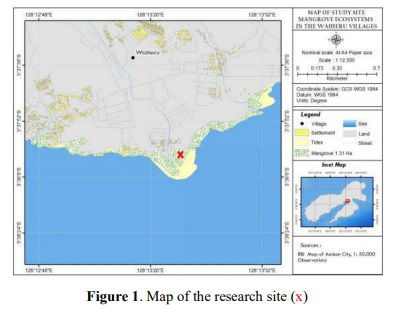Global Warming Potential of Carbon dioxide and MethaneEmission from Mangrove Sediment in Waiheru Coastal, AmbonBay.

ABSTRACT:
Mangroves can store carbon. However, it also produces carbon emissions by degrading organic matter in mangrove sediments. This research was conducted in a mangrove ecosystem at Waiheru, in the inner Ambon bay, to determine CO2 and CH4 emissions and their potential for global warming (GWP) from mangrove sediments. Gas is taken through a syringe mounted on the hood. Gas concentration analysis used the gas chromatography method, while the average gas concentration in each sediment was tested using ANOVA Single Factor. The results showed that the average concentration of CO2 gas was significantly different for each sediment (P-value <0.05), while the average concentration of CH4 gas was not significantly different (P-value >0.05). The largest CO2 gas emission in mangrove sediments in Waiheru Village was found in sandy mud sediments with an emission value of 136.99 mg.m-2 .h-1 , and the lowest was in sand sediments, namely 13.01 mg.m-2 .h-1 . Meanwhile, the largest emission of CH4 gas was in silty sand sediments, namely 0.32 mg.m-2 .h-1 , and the lowest was in sandy mud sediments, namely 0.15 mg.m-2 .h-1 . Fluctuations in carbon gas emissions in each sediment are inversely proportional, which indicates that the formation of CH4 gas is obtained through ethanol reduction, which utilizes CO2 gas concentrations. The total GWP in the mangrove sediments of Waiheru Village is 231.58 mg.m-2 .h-1 . The GWP contributed by the type of sandy silt sediment was 140.72 CO2-eq mg.m-2 .h-1 , muddy sand was 70.95 mg.m-2 .h-1 , and sand sediment was 19.91 CO2-eq mg.m-2 . h-1 .
1. Introduction
Increased emissions of greenhouse gases can trigger global warming to cause climate change. Climate change can impact various aspects of human life, such as agriculture (foodsecurity), health, and fisheries [1, 2]. Various studies have found that climate change impacts rising sea surface temperatures, sea level rise, rainfall, wind speed, lower seawater pH, seawater deoxygenation and heat waves [3]. These changes can decrease the benefits and ecological services of coastal marine, and freshwater ecosystems [4]. Meanwhile, it is reported [5], [6], and [7] that coastal and marine ecological damage due to climate change causes a decrease in fishery production and loss opeople's livelihoods. Besides carbon dioxide (CO2) and methane (CH4) gases, another contributor to triggering climate change is nitrous oxide (N2O). N2O has the potential to affect the climate more than 298 times compared to CO2 [7], and microorganism activities in the soil form N2O through nitrification and denitrification processes in aerobic and anaerobic conditions [8]. N2O increases significantly with increasing organic material concentration entering the aquatic environment [9]. Greenhouse gases that have the largest atmospheric concentration and are the main contributors to global warming are CO2 and CH4 [9]. These gases are produced by human activities, such as motorized vehicles, industrial, and burning fossil fuels, which causes accumulation of greenhouse gases [8, 9, 10]. Apart from human activities, the accumulation of carbon gas in the atmosphere can also occur naturally through the decomposition of litter produced by plant vegetation, including mangrove ecosystems [11,13]. Mangrove ecosystems can store up to 295 Mg C.ha-1 of carbon in tree stands [13]. Meanwhile, [14] stated that the total carbon storage in mangrove ecosystems, namely tree stands and substrates, reaches 1000 Mg C.ha-1 and is four times greater than other ecosystems.

